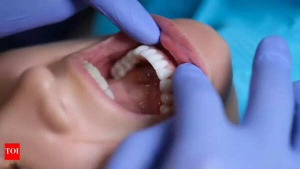Prediabetes is characterized by elevated blood sugar levels that haven't yet reached the threshold for a diabetes diagnosis. Early detection is crucial, as lifestyle modifications can often reverse the condition within months. While a blood test provides definitive confirmation, your body may exhibit subtle clues indicating elevated blood sugar. Here are five potential warning signs to watch out for. Note that these signs are not exclusive to prediabetes and could indicate other underlying health conditions.

One of the initial indicators of high blood sugar is excessive thirst. When glucose levels surge, the kidneys work overtime to filter out the excess sugar through urine. This increased urination can quickly lead to dehydration.
This creates a cycle of constant thirst, even with regular water intake. If you find yourself perpetually thirsty and making frequent trips to the bathroom, it could signal rising blood sugar levels.
Feeling unusually tired despite adequate rest can be a concerning symptom. Elevated blood sugar disrupts the body's ability to effectively use glucose for energy.

When cells are deprived of sufficient glucose, you may experience weakness and fatigue. This fatigue differs from typical tiredness, persisting even after rest. Difficulty concentrating or staying alert throughout the day may also be present. If you experience constant fatigue and daytime sleepiness, it is advisable to seek medical evaluation.
Prediabetes can manifest on the skin. Dark, thickened, and velvety patches may appear on the back of the neck, underarms, or groin. This condition is known as acanthosis nigricans.

These patches are associated with high insulin levels, common in prediabetes. If you observe these skin changes, particularly if they develop rapidly or worsen, it suggests your body may be struggling to regulate blood sugar.
High blood sugar impairs the body's natural healing capabilities. If minor cuts or bruises take an extended period to heal, it could indicate prediabetes.
Elevated glucose levels compromise the immune system and potentially reduce blood flow to the skin. This slows down the healing process and increases the risk of infections. If you notice wounds that are slow to heal, consulting a healthcare professional is recommended.
Individuals with prediabetes often experience increased hunger, even after eating. This occurs because the body's cells are not receiving enough glucose for energy. Consequently, the brain signals the need for more food intake, even when not genuinely hungry.
This amplified hunger can lead to overeating and weight gain, further complicating blood sugar management. If you experience constant hunger or cravings, especially for sugary or starchy foods, it may be your body signaling an underlying issue.
Newer articles
Older articles
 Samsung Galaxy A35 5G and A55 5G: Full Pricing and Specs Revealed
Samsung Galaxy A35 5G and A55 5G: Full Pricing and Specs Revealed
 Warning Signs: 5 Clues Your Body May Be Signaling Prediabetes
Warning Signs: 5 Clues Your Body May Be Signaling Prediabetes
 Expert Tips to Help Kids Sharpen Focus and Combat Distractions
Expert Tips to Help Kids Sharpen Focus and Combat Distractions
 SA20 Teams Allowed Up to Six Player Retentions, Enhanced by New RTM Card and Increased Salary Cap for Upcoming Auction
SA20 Teams Allowed Up to Six Player Retentions, Enhanced by New RTM Card and Increased Salary Cap for Upcoming Auction
 Brain's Eye View: Study Shows We See the World 15 Seconds in the Past
OR
The 15-Second Delay: How Your Brain Creates a Seamless, But Delayed, Reality
Brain's Eye View: Study Shows We See the World 15 Seconds in the Past
OR
The 15-Second Delay: How Your Brain Creates a Seamless, But Delayed, Reality
 Cervical Cancer: Don't Ignore These 5 Subtle Warning Signs
Cervical Cancer: Don't Ignore These 5 Subtle Warning Signs
 Science-Backed: 5 Simple Daily Habits for a Healthier Heart
Science-Backed: 5 Simple Daily Habits for a Healthier Heart
 Shimron Hetmyer's Last-Gasp Six Stuns MI New York, Orcas Complete Record MLC Chase
Shimron Hetmyer's Last-Gasp Six Stuns MI New York, Orcas Complete Record MLC Chase
 Oral Cancer: Spotting the Signs, Understanding the Risks, and Why Early Detection is Critical
Oral Cancer: Spotting the Signs, Understanding the Risks, and Why Early Detection is Critical
 Infrequent Bowel Movements: When Is It Time to Worry? A Guide to Healthy Digestion
Infrequent Bowel Movements: When Is It Time to Worry? A Guide to Healthy Digestion